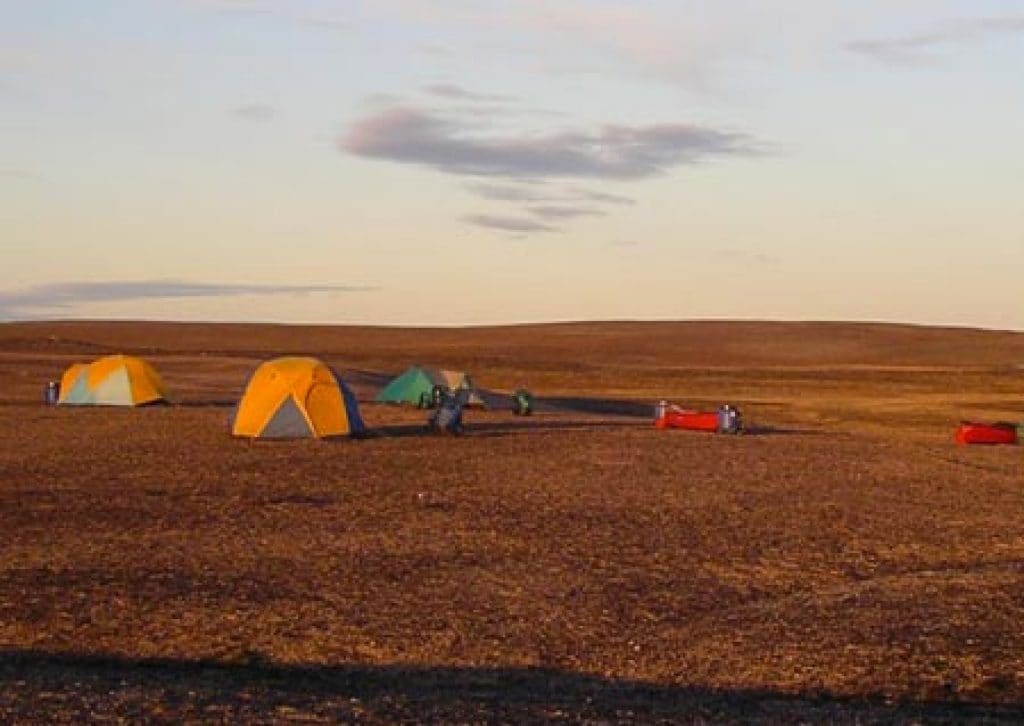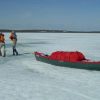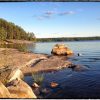Far North Tents, Tarps, and Shelters

Camping on the wide open tundra. All photos courtesy Brian Johnston.
Tents
Pack a good four season or expedition tent—the winds in the far north can be unbelievable. I have been in several 90 km per hour winds.
For two people, use a three-person tent. If tenting solo, use a small two-person tent. Once weather bound for several days you will love the extra space. There will be room for people to socialize, if the tent is partly wet, and space for an additional person if your group losses a tent.
Notable tent features include:
- Low profile and superior wind, rain and snow handling
- Poles, clips (fast) and/or sleeves (stable)
- Two doors, in case a door zipper fails or the wind shifts
- Vestibule
- Numerous tie-down points with guidelines
- Ventilation—tents heat up!
- Non-metal zipper pulls, quieter when wind bound
- Internal gear pockets and gear loft
Pegs or stakes for every tent stake loop and every tie-down, plus extra stakes for double staking guidelines
Interior ground sheet (collects dirt, protects tent floor, and aids moisture defense)
Exterior landscape material (landscape cloth, fabric or geotextile that you can get at a garden center for suppressing weed growth) will let water pass but protects against sharp twigs and rocks. Some people use house wrap like tyvek or typar for this purpose
I use an old camp towel to wipe off excess moisture before packing away the tent. It keeps my tent drier and lighter.
It took two of us an hour to put up our tent on the Prince River in near 100 km winds. On the Kazan River, we stayed put for several days during a summer arctic storm. Don’t underestimate the need for a quality tent.
Tarp Shelter
I’ve been on trips where we only used the tarp once or everyday—you never know.
Tarp shelter options include:
- Buckley fly and variations—some people add bug screen or mesh to transform their tarp into a bug shelter. See Cooke Custom Sewing
- Chlorophyll guide tarp—used by many commercial outfitters
- Mantis tarp by MEC—erect it tall or form a cave like shelter. It comes with bug screen so it can do double duty as a bug shelter
- Tundra tarp by Cooke Custom Sewing—some people add mesh sides
Tarp accessories:
- Poles—you can purchase (Cooke Custom Sewing or MEC) or use paddles. Combine two canoe paddles with a simple paddle connection system
- Pegs—pack many
- Rope—pack lots
- Cloth and webbing anchors—similar to a snow anchor but used with sand or rocks instead of snow
A Tarp Shelter as a Bug Shelter
Bringing only one shelter for both weather and bug protection saves space and weight but there is a downside. A tarp shelter has less airflow (a hotter bug shelter) and less view (missed wildlife viewing). I believe a Mantis Tarp or similar serves as an excellent backup bug shelter.
Bug Shelter or Kitchen Shelter
A screened kitchen shelter is a godsend on the buggy barrens. It is a place to gather for breakfast, supper, and an evening of visiting. During layover days, it’s the place to read, view, and nap. At times, it is even a bathing refuge from biting bugs.
A bug shelter needs to handle some wind. I add extra guidelines even though I lay it down overnight.
Bug or kitchen shelters include:
- Mesh hall by MEC—I love the spacious Gothic shape
- Bug tents—what I call the “picnic table” variety, by REI or similar retailer
There are small bug shelter options such as the solo or two person Walrus screen tent (hut), which are ideal for solo travelers or for bug free solo time, bathing, or washroom.
Bug or kitchen shelters accessories:
- Pegs—pack extra
- Rope—pack several extra guidelines
- Sunshade or light rain fly—an option provided with some bug tents
Next: Kitchen Gear
 Brian Johnston, Editor of the Paddle Canada Canoe Program. Brian has paddled Far North rivers of all kinds: swift descents from the mountains into the Mackenzie Valley, subarctic rivers emptying into the Arctic Ocean, traverses from the Northwest Territories to Nunavut, and drainages into Hudson Bay.
Brian Johnston, Editor of the Paddle Canada Canoe Program. Brian has paddled Far North rivers of all kinds: swift descents from the mountains into the Mackenzie Valley, subarctic rivers emptying into the Arctic Ocean, traverses from the Northwest Territories to Nunavut, and drainages into Hudson Bay.









